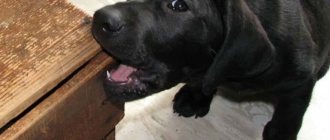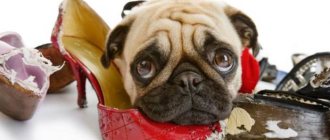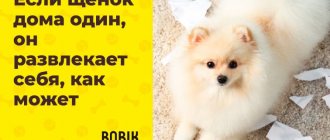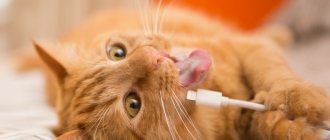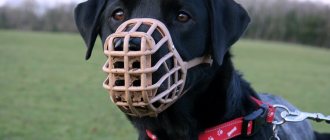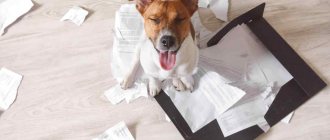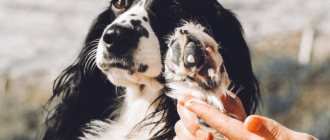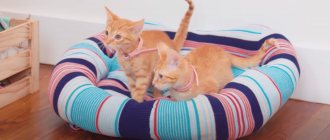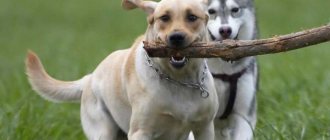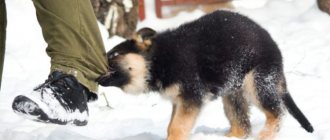Why do puppies chew everything?
Puppies of any breed of dog tend to chew on everything. This behavior is absolutely normal and necessary for their proper development. It is also important that dogs learn to bite “softly” at an early age, that is, without harming the object of the bite, as they retain this ability into adulthood.
You should not prohibit your puppy from biting various objects, because thanks to this behavior he explores the world around him. In addition, through bites, the puppy trains its sense of touch. It is also necessary to take into account the enormous energy of a small pet, which uses it through “biting” behavior and satisfies its curiosity.
It is also necessary to take into account the fact that puppies have baby teeth, which will be replaced by permanent teeth as they grow. Until this happens, they experience constant discomfort and anxiety and try to solve this problem with the help of bites.
The puppy chews everything: is this normal?
When considering how to stop a dog from chewing furniture, it is important to emphasize that up to 3 weeks of life, the puppy should be allowed to chew whatever he wants. This does not mean that you need to provide him with expensive items; the pet must have special toys for dogs. You should also allow him to bite his owners, in this way he will explore and recognize them. If the owners leave home and the puppy is left alone, unattended, it is necessary to place it in a special cage or lock it in a room where there are no valuables that the prankster could find and bite.
There is no need to worry if the puppy walks around the house all day and chews everything, this behavior is as necessary for him as sleep. However, if a pet begins to aggressively bite a family member or another pet, then this is the first bell for the owners to pay attention. As the puppy grows, owners must teach it so that it understands the difference in its bites.
Many people try to find a breed of dog that doesn't chew furniture, but it doesn't exist. No matter what breed the puppy is, biting and gnawing is a normal natural behavior line for him.
Causes of bad habit
To eliminate a bad habit, it is necessary to establish the reasons why the dog chews furniture. Experienced owners and veterinarians know that a healthy, happy pet will not spoil your things. Accept it as a fact that a dog that appears in your home will always strive to please you. If this rule is distorted, you have made mistakes during your upbringing.
Eliminate stress. Regardless of breed, age and size, a dog needs chewing as a method of eliminating stress, expending energy, calming down, eliminating discomfort associated with hunger and brushing teeth. Before taking any measures to correct behavior, it is worth teaching to clearly distinguish when a dog chews things for natural reasons and when its behavior is destructive.
Curiosity. A dog may chew on an object that has just appeared in the house due to curiosity. If you bought shoes or a chair, observe your dog's behavior towards the new item before leaving your pet at home alone. Puppies have a natural need to explore the world. Like small children, puppies taste the world around them during the process of socialization.
Discomfort in the oral cavity. One of the common causes of destructive desire is discomfort in the oral cavity.
- Puppies may chew on inedible objects due to changing teeth.
- Adult dogs may chew furniture (especially wood) due to toothache.
- Older animals chew hard, inedible objects to strengthen gums, remove plaque, or remove a diseased tooth.
Statistically, the most destruction occurs during puppyhood. In addition to oral discomfort associated with teething.
Lack of attention. Before buying a puppy, it is important to evaluate your capabilities, because until the pet is 1-2 years old, all your attention should be focused on its upbringing and socialization. Some dog breeds are very active by nature and require daily attention into old age.
Important! A dog may chew furniture just to get attention!
Boredom is a state of mind that pushes puppies and even adult dogs to engage in unwanted behavior in the absence of their owner. A dog will become bored if left alone for too long or not given enough exercise. When a puppy has nothing to do, his energy literally accumulates, in order to splash out his potential, the baby begins to destroy. The consequence of boredom can be not only destructive chewing, but also howling, barking, whining, peeing in inappropriate places, and self-injury.
Fear and anxiety. Quite often the cause of destructive chewing is fear or anxiety. For these reasons, incorrect behavior is observed not only in puppies, but also in adult dogs. Most often, the pet destroys objects in the absence of the owner in order to slightly reduce stress. To prevent anxiety in the absence of the owner, the puppy must be gradually taught to remain alone.
Restriction of freedom. In this case, the destruction occurs on the perimeter of the home or personal plot. A dog can chew wires, fences, wallpaper, doors. The problem is eliminated after increasing the duration and intensity of walking.
Note! Destructive behavior against the background of restriction of freedom may arise due to a low degree of socialization.
Avitaminosis. Puppies may chew inedible objects due to an unbalanced diet. Adult dogs know that furniture or wood is not food, but they can continue to chew on them due to severe vitamin deficiency and perversion of appetite. If your dog chews exclusively on wooden furniture, there is a good chance that he is lacking coarse fibers and fibre.
Mental disorder. Unfortunately, our pets can suffer from obsessive-compulsive disorder. Bad behavior that cannot be corrected may occur against the background of a weak or disturbed psyche. Such illnesses can occur in dogs adopted from shelters that have experienced severe stress or abuse. Weak psyche is a hereditary factor that can be observed in purebred animals.
Quite often, dogs chew furniture and personal belongings of the owner, only because they are not trained not to do so. While your puppy is exploring the world, you may be fascinated by his attempts to tear your socks or other things. The dog learns that its attempts to chew inedible objects amuse the owner and repeats this algorithm.
Training a small pet
To prevent owners from wondering in the future about how to stop a dog from chewing furniture, it is necessary to monitor the development of the pet from early childhood. To do this, you should adhere to the recommendations below:
- Considering that the puppy constantly bites everything, it is recommended to buy him appropriate toys. Every time your pet chews them, you need to praise him that he is doing the right thing.
- Starting from the age of three weeks, if the puppy bites its owners, you should emit a slight whistle and move away from the pet, ignoring it for one minute. This behavior of the owners will gradually teach the puppy to understand that this should not be done.
- You should try not to tease your pet too much while playing with him, as this can lead to strong and uncontrollable biting.
- In the process of training a puppy, for every correct action he needs to be praised, given tasty food and petted.
- If a child plays with an animal, then it is necessary to do this using dog toys so that the pet bites them and not the child.
Why does the animal behave this way?
When planning to get a dog, you need to weigh all the advantages and disadvantages of living under the same roof with a pet. Thus, many novice dog breeders are often unprepared for the fact that the dog chews furniture, shoes, wires, wallpaper and other things. When faced with problems in your pet’s behavior, do not rush to scold and punish the dog. First, you need to understand the reasons for this behavior of the family pet.
According to experienced dog breeders, almost all dogs at a young age, regardless of breed, try various objects in the house. We will now tell you what to do in such a situation and whether it is possible to somehow wean a dog from chewing things. First of all, you need to understand that the dog chews everything not out of harm or stupidity, but for some specific reason.
Teeth cutting
Puppies that chew everything that comes their way may be able to relieve the pain and discomfort caused by the eruption of chewing teeth in this way. At the age of 3 to 7 months, puppies change their milk teeth to permanent ones. If during this period you notice that your pet is sharpening its teeth on wood, walls, furniture, carpeting or shoes, you don’t even have to try to deal with this behavior. You need to be patient and wait.
However, if you do not control the process, then in adulthood the dog will continue to periodically gnaw on objects of interest to it. To distract your pet and ease the pain of teething, try offering your puppy a treat or rubberized toy that has been chilled in the freezer. Cold dulls pain and relieves discomfort.
Stress
According to experienced breeders, a dog can chew on everything when it is stressed. This behavior is typical for animals that have recently been adopted by a family (for example, a dog was taken from a kennel for homeless animals) and are afraid to be left alone.
It is not recommended to scold and punish a pet for spoiled things. This way you can provoke a reverse reaction, as a result of which the animal will begin to eat wires, furniture or shoes with greater zeal. You can help to overcome stress with the help of active games, training, a properly organized daily routine, as well as affection and attention.
Boredom
Left at home alone, a small puppy or an adult dog has fun on his own; often the object of such games is some things that get in the way. The reason for this behavior is simple boredom.
Many new dog breeders are interested in how to stop a dog from chewing shoes when you are not at home. Please note that this behavior requires correction of the animal’s daily routine. By increasing the number of active games and physical activity, you will save yourself from spoiled things throughout the house.
Avitaminosis
A lack of vitamins in the body can cause unusual gastronomic preferences in an animal. If you notice that your dog has started eating wallpaper, paint, stationery, soil from flower pots or waste from the trash can, it’s time to introduce complex vitamins and minerals into the family pet’s diet.
Intestinal problems
Another reason for a dog’s strange gastronomic preferences, when food waste, feces or things made from natural materials are consumed as food, is said to be problems with the functioning of the gastrointestinal tract.
Puppies recently weaned from their mother often suffer from indigestion and weak intestinal microflora. Often, such problems arise due to some kind of disease or early weaning from the mother, as a result of which the puppy does not receive enough lactobacilli and probiotics in the amount necessary for normal life.
Dogs that chew and swallow everything may suffer from parasitic organisms, including helminths. To help the animal, it is necessary to do deworming. It is recommended to remove worms at least once a quarter.
What to do if the puppy constantly bites its owners?
Different breeds of dogs develop differently: some take only a few weeks to understand what their owners want from them, while others can take much longer to learn. The main thing is that the owner constantly trains his pet, and then he will achieve the desired result.
If a puppy bites various parts of the body of its owners, and this behavior of the pet begins to bother family members, then you need to adhere to the following rules:
- Pretend that the bite is very painful. This method is effective if the puppy is not yet 3 months old. The owner, when the pet bites him, should make loud sounds indicating that he is in pain. After this, the owner should move away from the puppy and not pay attention to it. Over time, the pet will understand that it is doing something wrong.
- If the puppy is older than 3 months, then you need to do the following: when during the game the pet bites the owner, the latter needs to turn around and leave. After a few minutes, return and continue playing, and if the puppy bites again, leave immediately. This behavior from the owner will make it clear to the pet that every bite means the end of the game.
What methods don't work?
Punishing a pet a few hours after it has ruined something is considered an absolutely futile exercise. A smart dog, knowing that its behavior will not cause approval, tries to hide from its owner, but individuals with low intelligence joyfully rush to meet him, as if nothing had happened. If you punish a dog at such a moment, he will not understand that he is being punished for a spoiled thing, but most likely will believe that this is happening because he is showing his love.
The complete absence of punishment, when the owners let everything take its course, is categorically harmful. The pet must clearly understand that touching the owner’s things is prohibited.
Important! An ill-mannered dog is like a time bomb, because sooner or later furniture and shoes will be replaced by expensive things or, for example, cash or important documentation.
It is also worth considering the physiology of the animal. If your pet is teething, he will chew everything that comes in his way. Punishment in this case is useless; it is better to simply remove all objects.
Physical punishment is also ineffective, especially for small breeds, because it only leads to resentment, fear, and a desire for revenge. In addition, the animal may begin to bite in order to protect itself. Most likely, such a pet will simply destroy objects over and over again out of spite.
Temporarily ignoring the dog is a good way to achieve the desired result.
Reasons why an adult dog chews furniture
To understand how to stop a dog from chewing furniture, you first need to find out why he does it. It should also be noted that an adult dog chewing furniture is an abnormal behavior for which there is a completely logical explanation. Why does a dog chew furniture? Below is a list of the most likely causes:
- Disappointment over a breakup. The dog gets bored and starts chewing everything when the owners leave the house. The pet may also go to the toilet in places not intended for this and howl. In this case, it is very difficult to stop a dog from chewing things, so it is recommended to contact an appropriate specialist, as well as purchase dog toys that can keep your pet company for a long time.
- Hyperactivity. It manifests itself when the pet does not stop for a second and bites everything, even in the presence of its owners. In this case, you should buy “intellectual” toys for your pet, do not provoke or tease him, and devote sufficient time to training.
- Stress. Like humans, animals can also experience stress, which manifests itself in the form of apathy, fear, or, conversely, the pet begins to chew everything that catches its eye. To prevent the dog from chewing furniture in this case, it is necessary to analyze whether all the pet’s needs are satisfied, and if he lacks something, then this problem must be solved.
- Lack of physical activity. Being constantly at home and not receiving the required minimum level of physical activity, the dog not only begins to gain weight, but also experiences psychological disorders that can manifest itself in destructive behavior. If a dog chews furniture, what should you do? Solving this problem is quite simple; you just need to walk the dog every day.
Thus, there are various reasons why an adult dog chews furniture. What the owners should do in this case is described later in the article.
Training a dog
An animal that has not been taught to behave correctly among many interesting things will chew, studying them in this way - this behavior is characteristic of dogs of any age, so there is no point in being nervous or punishing the “rodent”. Correct behavior is to train the dog and control its behavior. When leaving home, lock her in a room where her behavior will not cause much harm, after leaving a few of her favorite toys there.
The dog chews furniture when left alone due to improper actions of the animal owner. This erroneous tactic gives her the firm belief that gnawing is okay when there are no people in the house! Punishment that is not tied to the immediate process does not form relationships in the animal’s behavior and does not teach.
Basic rules that you must reinforce in your dog:
- You can only chew on permitted things;
- this can also be done in the presence of people.
To prevent your dog from chewing furniture, you first need to block the opportunity to do so. To do this, the pet should wear a comfortable soft muzzle. After some time, the habit will gradually fade away.
If an animal has a habit of damaging not only furniture, but also tearing upholstery with its claws, it should be locked in an enclosure in the absence of its owners, leaving it alone with toys, bones and sticks that can be chewed. In order to distract your pet in your absence, it is good to fill a children's rubber toy that is empty inside with a substance that smells pleasant to the dog (dry food, biscuits). While having fun, she will chew on the object, which will reinforce the habit of doing this only with things permitted by the owner.
The best toys can be:
- Items made of hard, strong rubber;
- Purchased, specially processed, sterile bones;
- Special toys made of hooves and leather.
- your old things;
- used magazines and newspapers.
The next step is to leave the dog without a muzzle for a few minutes (2-4 weeks after the start of training). At the first attempts to gnaw, they are demonstratively punished and scolded. To distract, they throw keys or a jar of coins on the floor. If the dog does not see the person, such an action is associated with the action.
Then, after a while, they “forgive the rodent” and offer toys to help shape correct behavior. If the dog behaves correctly, they praise it just as loudly.
As the habit becomes established, it is left for a longer time; for this purpose, several steps are taken to be on the safe side:
- the dog is left after it has had a good walk outside and eaten a tasty meal;
- to protect things, use a product to prevent the dog from chewing furniture (Anti-gryzin);
- Be sure to leave several old toys and one new one;
- to teach not to touch the owners’ things, old unnecessary or already damaged things are left in a visible place;
- if the dog behaves correctly, they encourage and praise it; if it behaves poorly, they scold it loudly and demonstratively.
Persistence and patience will help owners shape the correct behavior of their pet.
If your dog is already chewing furniture and still has problems with his teeth, this can help him out. It contains natural ingredients that help heal teeth. Moreover, applying the gel cleanses teeth of plaque and stones and prevents the appearance of holes. It is enough to apply it to your teeth several times a week.
Pet training
When wondering how to stop a dog from chewing furniture, the first thing you should do is spend enough time training your pet, starting from an early age. At birth, puppies do not know how to behave correctly, what they can do, and what actions will spoil the owner’s mood. Therefore, if the puppy begins to chew furniture and other valuables, it is necessary to clearly and clearly tell him: “Ugh, you can’t!” It is necessary to understand that such a command should be given to a pet if it behaves inappropriately in front of its owner. Veterinarians also advise against resorting to physical punishment.
Alternative furniture for pets
As mentioned above, small puppies always chew on everything. Adult dogs can have a playful mood and often want to bite something. One of the great ways to stop a dog from chewing furniture is for the owner to offer an alternative for the pet so that it satisfies its natural need. This alternative is dog toys. There are a great variety of them currently on sale. For example, balls of fabric, rubber balls, soft and hard bones, kongs for dogs and others.
Regular physical training
Knowing which dogs chew furniture and why they do it, as well as the natural energy of these pets, you should provide them with an opportunity to burn off their energy every day. To do this you need to walk with them. Daily physical training is the basis for the proper physical and psychological development of a pet, and if it lacks physical activity, it begins to direct its enormous energy to the destruction of household furniture.
You can physically stress your dog in various ways:
- long walks with your pet;
- active games with the dog in the fresh air;
- dog playing with other pets.
If the owner does not have the constant opportunity to spend sufficient time with his pet, then veterinarians recommend occupying his attention with various toys that will develop not only the physical qualities of the pet, but also his mental abilities.
Correct actions are the key to success
A dog trainer is the best person to handle the training, but a dog breeder can train his pet himself.
The main thing is to perform all actions systematically and adhere to simple rules.
Instead of furniture - toys
Furniture and shoes are chewed by young dogs. If the puppy spoils everything that gets into his teeth out of boredom, then the baby needs to be given interesting objects that will allow him to take his mind off the damage of everything that surrounds him.
There are many toys and treats on the market today that are designed for dogs. It is advisable for the dog to have several of them. After all, monotonous games can quickly get boring.
It is advisable to choose toys for the owner and pet to spend time together, as well as those with which the animal can have fun on its own.
To make them more attractive, wood shavings and bone meal are often added to their composition. Dogs are attracted to these smells.
Favorite treat - and things are intact
Pets love to chew bones. However, it is not recommended to give them to your dog.
An animal can split a bone with its teeth and damage its oral cavity. In addition, sharp fragments can become lodged in the throat and cause serious problems.
However, you should not deny your pet the pleasure of gnawing on a bone. Instead of the usual options, you can purchase special treats at the pet store. They are absolutely safe for the animal and have a positive effect on the condition of the teeth. If the puppy has such an alternative, interest in the owner’s things will disappear.
An old shoe is not a toy
Often dog owners themselves give their pet old things to play with.
The dog does not understand the difference between already damaged and new objects. As soon as she gets rid of the old shoe, she will take on a new one .
The dog must know that absolutely everything that belongs to the owner is prohibited for him.
Valuables are kept under lock and key
When leaving home, you should be on the safe side and remove all valuables from your pet’s sight.
It is also recommended to protect the puppy from contact with electrical wires. If he starts gnawing on them, he could get seriously hurt.
Smell is like a barrier
Not all objects can be hidden from the puppy.
To prevent the baby from touching them, you can use sprays with a smell that the little mischief does not like. When he feels the aroma emanating from the objects of interest, he will not even want to approach them and will not taste them.
Walking is a priority
So that the dog simply does not have the strength to play pranks and damage things, it needs to be walked outside for a long time.
It is extremely important to take your dog for a walk before leaving home. You need to play with your pet outside and give him the opportunity to run out. When he returns home, he will no longer want to frolic. It will be much more pleasant for him to simply relax on his bed than to spoil his shoes or furniture.
Fenced space as a way out of the situation
You can install a spacious cage in the room, in which the pet is placed for the time when he is left alone.
Don't worry about your dog feeling uncomfortable in a confined space. If everything is done correctly, the puppy will perceive the crate as a cozy kennel.
You need to place a bed and toys there. After the cage with the animal is closed, you can safely go about your business. All things will be completely safe.
Furniture protection
Solving the problem of a pet damaging furniture can take some time. Therefore, many veterinarians advise protecting it in one way or another. Firstly, you can use special protective covers or blankets for furniture, which are easy to replace if the dog damages them. Secondly, you can use special natural substances that are not toxic, but at the same time repel the animal.
The dog is chewing furniture, what should I use to treat it? Lemon juice or red pepper is suitable for this purpose. You can also buy a special dog-repellent spray that should be used on furniture and other items of value.
The principle of weaning is extremely simple
When you see that the dog is chewing furniture, give a prohibiting command. Offer the toy immediately. Be sure to interest the puppy. When your pet switches to “legal” entertainment, praise and support vigorously. This way you will show your pet what you expect from him.
Observe, stop and regularly update the range of toys. Hide the old ones, give us new ones. Change the “set” about every week to prevent the puppy from getting bored. Soon the pet will understand that it is much more profitable for him to chew more pleasant rubber and receive the approval of the owner.
Restricting your dog's access to certain areas of the house
If the owner has tried various methods on how to stop a dog from chewing furniture, but his pet continues to do it, then the only 100% way to prevent such unwanted behavior is to keep the dog away from certain places in the house, for example, always close the doors to the room where the furniture is. . If the owner has resorted to this method of solving the problem, then you need to know that leaving the dog alone for a long time closed in a small room is not recommended, as this will provoke a feeling of melancholy in the pet or increase stress, which will further aggravate the problem.
Behavior correction methods
Is it worth getting angry at a young dog who has so much energy and strength if, out of boredom, she has not found anything to do other than shred the owner’s things?
To stop your dog from chewing things, damaging furniture and wallpaper, there are proven methods that you need to follow.
- Visit the nearest pet store, buy the dog a couple of toys and teach him to play only with them. Praise the dog for frolicking with things intended for this purpose, scold him for deviating to the side.
- Use special sprays. Theoretically, you can also use the power of smell: pet pharmacies sell special sprays, the composition of which has such a negative effect on the dog that he does not go to the corner where the smell of the spray is noticeable. It is better to check with your veterinarian which specific product to buy.
- Apply citrus essential oil. If you buy orange and grapefruit essential oil and apply it to the corners of furniture, walls, or any other place in the house that your dog doesn't like, he will start to walk around it. For people, such smells are pleasant (so you yourself won’t suffer), but animals do not tolerate the smell of citrus fruits; for them it is pungent.
- Establish team training. Finally, resort to intellectual methods of unlearning. The dog must clearly distinguish between prohibiting commands - “fu” and “no”. These limiting words are pronounced in a stern voice with an appropriate facial expression. They need to be said every time the dog decides to tatter the owner’s slippers or give street shoes a teeth test. The training process requires strictness: no playful form or meaningful intonations - the dog will clearly understand this and will not refuse to play with you. The owner of a mischievous puppy squeezes his withers and says “no” or “ugh” in a stern, commanding voice. It is no longer possible to squeeze the withers of an adult dog - this humiliates him.
- Walk the dog more. Sometimes that's all there is to it. It happens that a pet chews on the shoes of one person or begins to drag his shoes, thereby showing that he yearns for walks. This can be done by puppies who, due to their age, are still inconsistent and willful. Of course, you can’t praise the dog for such unique resourcefulness, but you need to listen to such “requests”. If the dog has had enough fun on the street, if he has had enough of communicating with his owner, he will not have the strength left for destructive activity at home.
- Give him non-sharp bones. This way the animal will be able to satisfy its own hunting instinct, and your things will remain intact.
- Make sure you are successfully preventing your dog from being dewormed. There is an opinion that it is worms that cause anxiety to the animal, and it expresses it in excessive gnawing. Deworming tablets should be given to your pet according to the schedule received by the veterinarian (usually once every 3 months).
- Teach your dog not to be afraid to stay home alone. This is an important psychological point, based on building a trusting “master-dog” scheme. Many dogs are simply bored, they are afraid of forced loneliness, so they begin to squabble. The more you communicate with the animal, the more you demonstrate your joy when you come home, the faster he understands that being alone sometimes is normal. When leaving for work, talk to the puppy and explain: “I’ll be back soon, behave well, here are your toys.” And when you come home, praise them for their purity and obedience.
- Walk with the dog according to the schedule. If the dog knows that it’s time for a walk soon, he will be calm and will not chew on everything.
Finally, take responsibility for all educational activities yourself. Do not make concessions, be strict in your requirements. In the meantime, while the puppy is growing and can play pranks, do not leave valuables within his reach. Provocation is not a method of education.
What else can you do to prevent your pet from chewing things: recommendations from dog owners
If you cannot stop your dog from chewing things using the methods listed above, or the problem is partially solved, then it is recommended to seek advice from specialists, for example, people who train dogs or veterinarians. You can also tell pet lovers about your problem, who will tell you what to do in this situation.
Many dog owners say that problems with destructive behavior in their pets begin when there are two or more dogs in the house, and different ages of pets can only worsen the situation. For example, an adult dog begins to actively play with a puppy, and their games are accompanied by the destruction of furniture. In such cases, owners advise paying great attention to training their pets, as well as isolating them from each other when the owners leave home and leave the dogs alone.
How to stop a dog from chewing things
Here are some basic rules to help you stop your dog from chewing things:
- Load your pet with physical activity. Don’t just go outside for him to go to the toilet, but also after the four-legged one has done his business, arrange active games. Let your four-legged friend run and play enough so that he gets tired. Such a dog will no longer have the strength to chew anything in the apartment. She will spend most of her time sleeping and gaining strength. Many will say: I don’t have time to walk for so long, I have a lot to do, I have to go to work. To this I will answer one thing: if you have no time, then why did you get a dog? Before getting an animal, you should carefully consider whether you can devote enough time to your pet so that it does not feel unhappy and abandoned. When getting a dog, you must be prepared for the fact that you will have to radically change your usual way of life.
- Walk your dog longer and more often. An adult pet should be walked 2-3 times a day. The puppy is from 5 to 10.
- After your walk, feed your dog well. On a full stomach, a dog always feels calmer, more confident and less anxious.
- Leave toys and chews when you go to work. But do not give your pet all the toys at once. Every day, leave him a couple of new toys (those he hasn’t played with for a long time), and hide the old ones he’s just been fiddling with. And so alternate. The animal gets bored with the same toys. But if you alternate them, then the tail will simply have time to miss the toys that it has not seen for a long time, and will play with them with great interest.
- Give your pet something to do. Leave the tail some tasty treats. It could be cartilage, beef trachea. Leave the treat as a whole piece so that the dog cannot deal with it instantly. The owner's care should be associated with good emotions for the four-legged dog, and not with stress. On top of that, cartilage is very beneficial for the growing body of a puppy and for adult dogs. In addition, this is a good prevention of dental plaque. But keep in mind that you shouldn’t give them often either. Once every two days is enough. Otherwise, there may be problems with digestion. But I absolutely do not recommend leaving the bones. And not only in your absence, but never at all. Read about why it is harmful to give your dog bones.
- Do not give old slippers or boots to be torn to pieces by a four-legged animal. A dog cannot distinguish between shoes that can be chewed and those that cannot. If you laugh merrily when the puppy deals with old slippers, then when you are not at home, he will deal with new expensive boots just as cheerfully and naturally. The puppy thinks like this: what’s wrong with that? After all, the owner was happy when I tore apart the prey (slippers), how clever and brave I was. This means that he will also be happy if I deal with a more formidable opponent (boots).
- Praise your pet when he plays with his toys.
- Leave the radio or TV on if the puppy is still small. This will create the effect of presence. But carefully check that all wires are out of the baby’s reach.
- Follow a daily routine. It will be easier for the animal to wait for a long and active walk with the owner.
- Follow the rules for keeping dogs in the apartment. Do not leave small objects within the animal's reach that may interest it.
- Take obedience classes with your pet. This will help correct the four-legged behavior.
- Organize a personal space for your pet. If your furry friend is still very young and you don’t have time to be with him all the time, then he should have a fenced-in corner where the puppy will only have access to certain items. It can also be a large cage, in which you need to organize a place for the baby in such a way that he does not remain in complete isolation, but can calmly see and observe what is happening around him. The cage or enclosed space should have everything you need: a bed, a diaper so that the tail can go to the toilet, toys, chews and, of course, a bowl of water. If you go somewhere, the cage can be closed during your absence. And if you are at home, then let the cage door always be open. The puppy is under your supervision and must move freely in space. Read about keeping a pet in a cage in an apartment.
- Treat the interior items that your pet has “loved” with products from a pet store that have a strong, repulsive odor. But based on the experience of our dog breeder neighbor, we kept it simple. I bought fresh hot red chili peppers and cut them into two parts. Then she smeared it on those areas of the furniture that our Jack liked when he was cutting his molars and needed to scratch his gums. At first, Jack, out of habit, came up and began to gnaw at the corners, but the action of the pepper did its job. Jack began to lick his lips, sneeze and immediately ran away. Yes, of course, he then tried to come up and chew those corners of the furniture that he had already begun to chew. But now he no longer immediately rushed to gnaw them, but carefully approached, sniffed, began to sneeze and immediately walked away again. After that he was no longer drawn there. This is how we stopped our Jack from chewing furniture.
